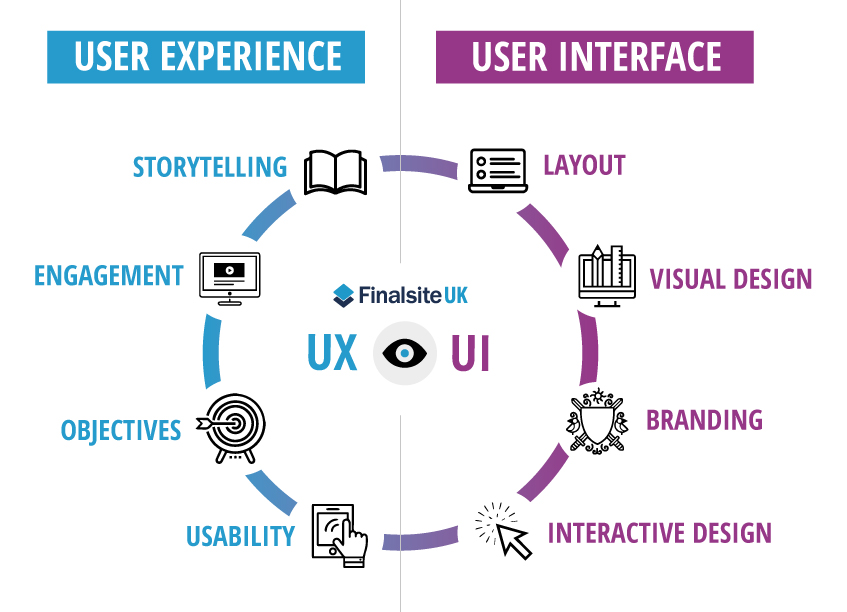What is User Experience (UX) Testing? How to do it? How does it influence CRO?
Recently updated: July 13th, 2020
Getting your site ranked on the first page is not enough for your brand’s reputation and image. The experience your website users have once they click on the link plays a great role in whether they want to stay on your website to get what they are looking for. Their first experience also decides whether they’ll want to come back to your site in the future or not. But, how can one improve the User Experience (UX) of their website? The answer is User Experience Testing.
Today, we will discuss User Experience (UX) Testing and also cover the following topics:
- Why is UX Testing important for any website?
- What are different UX Testing methods to analyze the current user experience?
- How to conduct UX testing?
- How are UX and CRO interrelated and how do they impact each other?
What is User Experience (UX) Testing?
User experience (UX) Testing allows you to analyze your website so that you can make changes to improve the experience of users on your website. It helps you test various elements and areas of your site that can influence your users and determine why and what to optimize on your site.
Through UX Testing, you can collect valuable information about users’ perception, what they like, what they don’t like, what they tend to click, which navigational style is easier for them, what categorization of products and services allow users to easily find and explore things on your site.
Note that UX and UI are not the same things. Here, UI stands for User Interface and it is a component of User Experience (UX).
Difference between UX and UI
While UX refers to the user’s entire experience right from landing on your website to leaving your website, UI refers to the visual layout of the elements through which a user interacts within a website page.

Image Source: Finalsite
Why is UX Testing important for any website?
You might not be swayed by our saying that UX is critical for all websites, but the following UX statistics will certainly help you realize how important UX is to a website.
- The recent findings from Forrester Research show that “a well-conceived and frictionless UX design can potentially increase the conversion rates by 400%”.
- According to Toptal Designers, 88% of users are less likely to revisit a site after having a bad user experience.
- As per Miklos Philips’ article – Know Your User, mobile users are 5 times more likely to abandon a task if a site is not optimized for mobile devices.
- Research done by Forrester revealed that for every $1 invested in UX brings $100 in return.
- The same research conducted by Forrester also disclosed that if you use UX design to satisfy enough people to increase retention even by 5%, you will be able to enjoy at least a 25% boost in the profit.
- Capgemini stated that 8 in 10 customers are willing to pay more for a better experience.
- Forbes published that Jeff Bezos invested 100 times more into customer experience than advertising during the first year of Amazon.
UX Testing is no longer just a competitive advantage for a business. It has become a mainstream contributor over the past few years and is going to be more crucial as people are loaded with hundreds of options to choose from. If they aren’t going to like your website or they experience any friction, they can switch to your competitors without any hesitation and delay.
Users judge a website in no time. One bad experience and you lose one potential customer. While one customer may not sound bad to you, losing hundreds or thousands of customers because of poor experience and your negligence to UX design will surely leave a dent in your revenue.
A smart business owner always pays attention to providing a seamless, frictionless, and excellent experience and improving their website design and performance continuously. It’s like correcting an issue from its root cause rather than treating symptoms.
So, it’s on you what kind of result you want and how to achieve that.
What are different UX Testing methods to analyze the current user experience?
Now that you know what UX testing means and why it is important for your website, it’s time to know different UX Testing methods so that you can also conduct UX Testing for your website as well. Know that UX testing is not a straightforward process.
First of all, wait for a second and think about your website and goals. We know you obviously want to boost your sales, but how can you make it happen? With just a single click, you aren’t going to flood your bank account with money.
Rather, you should focus on what impresses your consumers to buy your products and services or what dissuades consumers to not buy your products and services. Figuring this out is what lies at the core of UX testing.
To multiply your sales, you need to fulfill your customers’ needs and meet or exceed their expectations. Think about what they need to do to complete the checkout process.
- Navigate your site
- Access product information
- Check CTA buttons
- Easy checkout process
- Trust symbols for payment
- Social proof, especially in today’s environment
The list can be very long because what one audience needs, it’s not necessary that another might need that as well. So, you shouldn’t follow any method or practice blindly.
UX Testing is not like other tests where there are certain parameters that you can check in a pre-defined way. For UX testing, you come with a question or identify an issue, generate a hypothesis, set up the experiment with the help of some real-world users, run tests, and analyze what review, information, or issues the users provide you with.
The following methods and information are just to give you a head start. However, you have to figure out what works best for you by testing your hypotheses with your own customer/user base.
- Customer Voice
It could be surprising to know that only a few customers report about their dissatisfaction. This means you’re never going to know what bothers your customers the most as the majority of them don’t share their bad experience at all.
So, find ways to listen to your customers’ experience. You get insightful information through service or product reviews, reviews on third-party websites, emails, phone calls, and feedback forms. Leverage every feedback you get from customers and add them to the database for analysis. You can even run quizzes or campaigns to get information on the experience your users have on your website.

Image Source: CallCentreHelper.com
Alternatively, you can set up a poll or survey to ask the opinions of people directly. You can do it on your social media accounts, blog, websites, or anyplace you want. The main idea is to get the customers’ opinions and feedback. If they don’t reach you, you can reach them. Don’t just wait.
- Card Sorting
Though it may sound boring, card sorting is actually a fun activity through which you can determine how the elements of your website should be categorized. While you don’t know the order at first, you will figure out as the test is conducted.
Prepare some cards with information on the backside about the product description. Then, ask the participants or users to sort and categorize the content. You can use this method to categorize website components such as support pages and informational content as well as products and services.

Image Source: JustInMind
The best part is you can conduct card sorting in person as well as virtually through an online tool. The ultimate goal is to know how users prefer the categorization of elements or products.
- Moderate User Testing
During moderate user testing, there is a professional among the users who guide them. The professional moderates the testing experience and that could be done in a room with participants or a moderator in a discussion room.
In both cases, the moderators answer the questions from participants, guide them throughout the process wherever the need arises, and share the goals you expect to achieve through the website.

Image Source: Hotjar.com
This type of testing is useful when you need to explain to the users/participants how a product or interface works. In case where confusion can’t be solved, there might be an issue with user experience. Later, the moderator can report back what he/she noticed and gathered during testing.
- Unmoderated User Testing
It is considered that unmoderated user testing is more effective as the result and users’ opinions aren’t affected because of the moderator. Through this testing, you will be able to know the actual feelings of users when nobody is there to distract them.

Image Source: GrowRevenue.io
But with this testing, you also need to leave some slack to consider user errors and unfocused participant behavior.
So, to get more precise information, it is good to conduct both moderated and unmoderated testing.
- A/B Testing
When it comes to finding which version produces better results, A/B testing is the way to go. Compare two versions of a website, page, text, image, or button, collect results from your target audience, find out which version is more successful.

Image Source: KDnuggets
We understand that you haven’t got all the time to do everything on your own. So, we would suggest you use UX testing tools as they allow you to get access to high-quality data and well-developed analytics.
Here are some of the popular UX Testing tools:
- Optimizely
- Crazy Egg
- GTmetrix
- BrowserShots
- Zurb
These tools help you view heat maps, see recordings, and analyze scroll maps to get insightful information about the users’ activities.
A Few Useful Tips for UX Testing
- Try to conduct tests with more users or participants as it leads to more accurate results.
- Choose your test participants who belong to your target audience. For instance, if you are testing a game app, you wouldn’t want people to become your test participants who don’t have any interest in games. For that, you can harness the existing website traffic.
- One test is never enough to get insights. You should keep running tests because as your brand and business evolve, your customers also evolve.
- If you haven’t conducted UX testing before, you don’t have to wait anymore. As soon as you get enough website visitors or participants, start conducting UX testing for your site.
How to Conduct UX testing?
Check out the steps you need to follow for conducting UX testing.
- First, determine your goals as to what you want to know or achieve through UX testing. While many businesses focus on sales, some focus on increasing downloads, and others may have the goal of getting more sign-ups.
- Once you know what you want to achieve, choose the UX testing method that best aligns with your goals. There are several methods that you can choose but you need to select the one that will help in achieving your goals and fit within your budget.
- Establish a well-laid plan that contains information about everything, including what you want to test, how you will test it, how you will run the test, who your participants will be, how to measure the results, what metrics are important to you, and so on.
- Analyze your results; otherwise, you aren’t going to know what causes friction and what’s working fine.
How are UX and CRO interrelated and how do they impact each other?
By now, you have gained all the basic knowledge about User Experience and UX testing. So, here comes one of the most arguable topics related to UX: how user experience impacts the conversion rate optimization (CRO).
Rather than wasting time in deciding which one is part of another, we will focus on how they are useful to each other.
Both User Experience (UX) and Conversion Rate Optimization (CRO) terms are similar in terms of meeting similar goals with the help of analytics and feedback.
Rather than considering them as mutually exclusive processes, just remember that they complement each other and their combination can greatly help in achieving various website and business goals.

Image Source: UX Writing Hub
Here is how UX influence CRO:
a) UX Testing provides a solid base for CRO.
Conducting random experiments is not as effective as it is when you conduct these experiments based on UX testing results and findings. When website analysts test an idea based on UX research, it is going to show much better results because, this time, you are not shooting in the dark. You have facts, feedback, and research on which you can base your CRO experiments and hypotheses.
Thus, introducing UX research into the CRO department allows you to say goodbye to random CRO experiments and help you save time and money. Experiments driven by UX research are more effective, insightful, and valuable.
While CRO helps you know that something needs to be changed in the current experience, UX research enables you to figure where to start.
b) UX Research helps locate major issues and prioritize them.
You might make some improvements by changing the color of a button for conversions. But, if there is some fundamental issue with your website design, you will still be facing problems no matter how harder you focus on CRO.
To make a significant difference, you need to focus on enhancing the website’s user experience while concentrating on conversions. If you don’t, your chances of conversions will still be slim, no matter how much you optimize the website. So, never leave the usability tests for UX designers alone. CRO professionals should be open to leverage UX research to identify issues and prioritize them as well.
c) UX can help explore new opportunities.
There is no secret that most CRO professionals design hypotheses or test setups keeping only desktop sites in mind. But, UX designers don’t. They focus on different devices and have a deeper understanding of what types of changes perform better on what device.
Since it is not essential that a change in the desktop site will work the same for mobile version also, it is critical to prepare a strategy in coordination with UX designers.
UX designers can help CRO professionals to increase conversions for mobile-optimized sites as well.
On the other hand, UX designers can refer to the tests and experiments conducted by CRO professionals to gather insights that designers might have missed and avoid carrying out experiments that have already been conducted by the CRO team.
Conclusion
A website is considered successful when it is able to bring leads for a business. Anything less which swerves potential customers from your website to competitors can be disastrous. So, it is better that you pay attention to not only SEO but also UX as it defines whether website visitors will convert into potential customers and then into actual customers or not. If you haven’t thought about enhancing user experience until now, you must start working on it right away.
Latest posts by Vijaya Tyagi (see all)
How To Track Shopify SEO Performance & Metrics (2025) - January 14, 2025
Link Building Strategies: The Ultimate Techniques for 2025 - December 31, 2024

